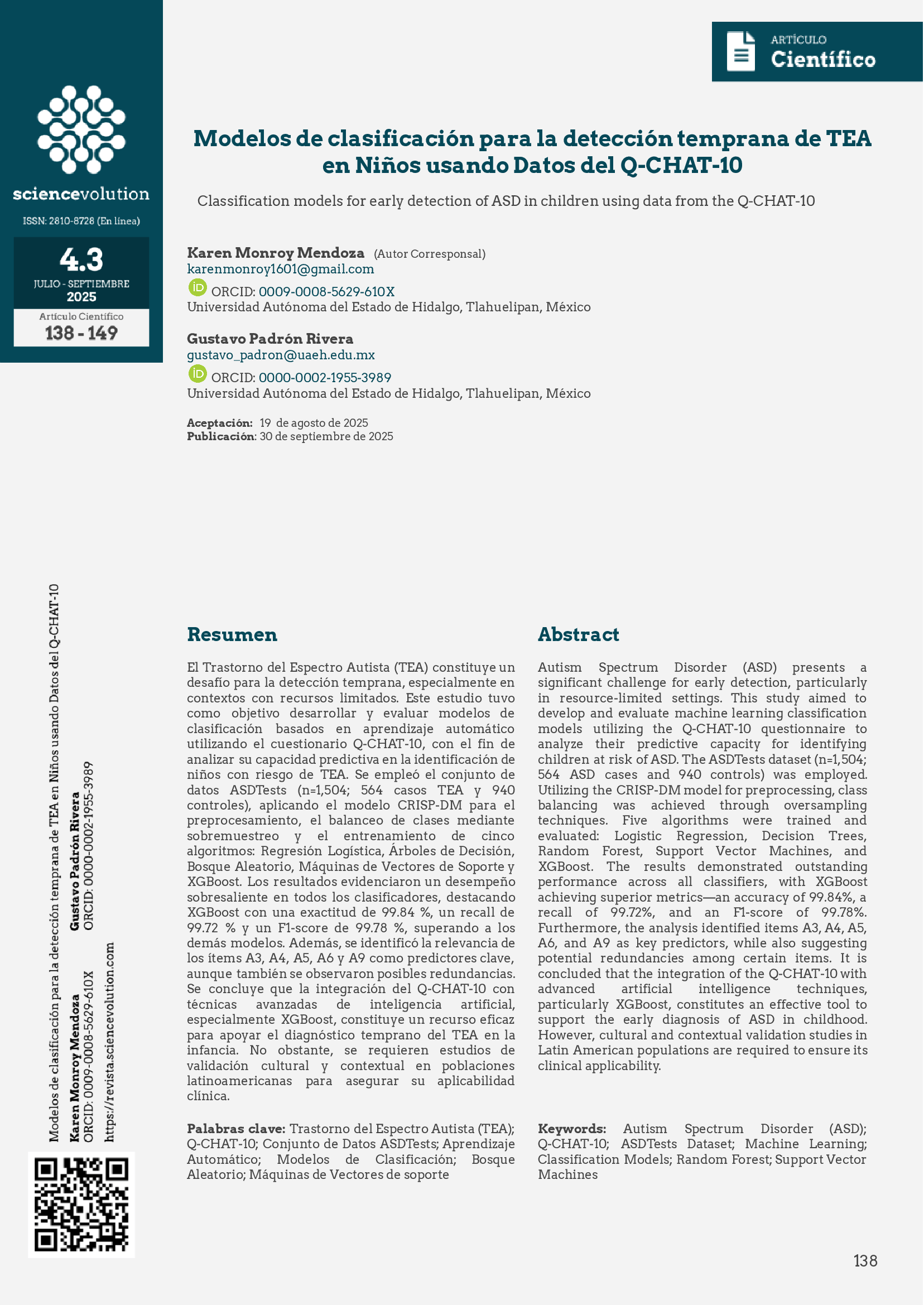Abstract
Autism Spectrum Disorder (ASD) presents a significant challenge for early detection, particularly in resource-limited settings. This study aimed to develop and evaluate machine learning classification models utilizing the Q-CHAT-10 questionnaire to analyze their predictive capacity for identifying children at risk of ASD. The ASDTests dataset (n=1,504; 564 ASD cases and 940 controls) was employed. Utilizing the CRISP-DM model for preprocessing, class balancing was achieved through oversampling techniques. Five algorithms were trained and evaluated: Logistic Regression, Decision Trees, Random Forest, Support Vector Machines, and XGBoost. The results demonstrated outstanding performance across all classifiers, with XGBoost achieving superior metrics—an accuracy of 99.84%, a recall of 99.72%, and an F1-score of 99.78%. Furthermore, the analysis identified items A3, A4, A5, A6, and A9 as key predictors, while also suggesting potential redundancies among certain items. It is concluded that the integration of the Q-CHAT-10 with advanced artificial intelligence techniques, particularly XGBoost, constitutes an effective tool to support the early diagnosis of ASD in childhood. However, cultural and contextual validation studies in Latin American populations are required to ensure its clinical applicability.
References
Abbas, R. T., Sultan, K., Sheraz, M., & Chuah, T. C. (2024). A comparative analysis of automated machine learning tools: A use case for autism spectrum disorder detection. Information, 15(10), 625. https://doi.org/10.3390/info15100625
Abdelwahab, M. M., et al. (2024). Predictive models for early autism spectrum disorder detection. Journal of Developmental Research, 15(1), 123-135. https://doi.org/10.57197/JDR-2023-0064
Aldrees, A., Ojo, S., Wanliss, J., Umer, M., Khan, M. A., Alabdullah, B., Alsubai, S., & Innab, N. (2024). Data-centric automated approach to predict autism spectrum disorder based on selective features and explainable artificial intelligence. Frontiers in Computational Neuroscience, 18, 1489463. https://doi.org/10.3389/fncom.2024.1489463
Allison, C., Matthews, F. E., Ruta, L., Pasco, G., Soufer, R., Brayne, C., Charman, T., & Baron-Cohen, S. (2021). Quantitative Checklist for Autism in Toddlers (Q-CHAT). A population screening study with follow-up: The case for multiple time-point screening for autism. BMJ Paediatrics Open, 5(1), e000700. https://doi.org/10.1136/bmjpo-2020-000700
Argentieri, M. A., Morley, M., Perls, T. T., & Miljkovic, I. (2025). Integrating environmental and genetic architectures of aging: insights from machine learning and Random Forest approaches. Nature Medicine, 31, 123-132. https://doi.org/10.1038/s41591-024-03483-9
Ehsan, K., Sultan, K., Fatima, A., Sheraz, M., & Chuah, T. C. (2025). Early detection of autism spectrum disorder through automated machine learning. Diagnostics, 15(15), 1859. https://doi.org/10.3390/diagnostics15151859
El-Sayed Atlam, M., Masud, M., Rokaya, M., Meshref, H., Gad, I., & Almars, A. M. (2024). EASDM: Explainable autism spectrum disorder model based on deep learning. Journal of Data and Robotics, 3(1). https://doi.org/10.57197/JDR-2024-0003
Fernández-Blázquez, M. A., Castrillo, J. I., DelPozo-Banos, M., & Sarria-Paja, G. (2025). XGBoost models based on non-imaging features for the prediction of mild cognitive impairment conversion. Scientific Reports, 15(1), 8423. https://doi.org/10.1038/s41598-025-14832-0
García, M., & Gago-Galvagno, P. (2025). Parentalidad positiva y competencias parentales en familias con niños con Trastorno del Espectro Autista en Buenos Aires, Argentina. Revista Psicología y Educación, 20(1), 1-12 https://ri.conicet.gov.ar/handle/11336/264245
García-Zambrano, S., Orozco-Barrios, L. G., & Jacobs, E. (2022). Estimation of the prevalence of autism spectrum disorders in Colombia based on the governmental data system. Research in Autism Spectrum Disorders, 98, 102045. https://doi.org/10.1016/j.rasd.2022.102045
Jima Cuenca, J. T., Castro Villalobos, S., & Ramírez, A. (2025). Prevalencia del Trastorno del Espectro Autista (TEA) en infantes: revisión sistemática y metaanálisis. LATAM Revista Latinoamericana de Ciencias Sociales y Humanidades. Asunción, Paraguay. Recuperado de https://dialnet.unirioja.es/descarga/articulo/10118352.pdf
Mujahid, M., Kına, E., Rustam, F., Gracia Villar, M., Silva Alvarado, E., De La Torre Díez, I., & Ashraf, I. (2024). Data oversampling and imbalanced datasets: An investigation of performance for machine learning and feature engineering. Journal of Big Data, 11, 87. https://doi.org/10.1186/s40537-024-00943-4
Nawaz, A., Ahmad, A., Khan, S. S., Masud, M. M., Ghenimi, N., & Ahmed, L. A. (2025). An efficient interpretable framework for unsupervised low, very low, and extreme birth weight detection. PLoS ONE, 20(1), e0317843. https://doi.org/10.1371/journal.pone.0317843
Roman-Urrestarazu, A., Yáñez, C., López-Garí, C., Elgueta, C., Allison, C., Brayne, C., Troncoso, M., & Baron-Cohen, S. (2020). Autism screening and conditional cash transfers in Chile: Using the Quantitative Checklist (Q-CHAT) for early autism detection in a low resource setting. Autism, 25(4), 1075-1086. https://doi.org/10.1177/1362361320972277
Salmi, M., Atif, D., Oliva, D., Abraham, A., & Ventura, S. (2024). Handling imbalanced medical datasets: Review of a decade of research. Artificial Intelligence Review, 57, 273. https://doi.org/10.1007/s10462-024-10884-2
Schonhaut, L., Buron, V., Aguilera, R., & Vargas, L. (2023). Detección temprana de Trastorno del Espectro Autista: revisión de las herramientas de tamizaje validadas en Chile. Revista Chilena de Pediatría, 94(4), 548-557. https://doi.org/10.32641/andespediatr.v94i4.4901
Schröer, C., Kruse, F., & Gómez, J. M. (2021). A Systematic Literature Review on Applying CRISP-DM Process model. Procedia Computer Science, 181, 526–534. https://doi.org/10.1016/j.procs.2021.01.199
Tartarisco, G., Cicceri, G., Di Pietro, D., Leonardi, E., Aiello, S., Marino, F., Chiarotti, F., Gagliano, A., Arduino, G. M., Apicella, F., Muratori, F., Bruneo, D., Allison, C., Baron-Cohen, S., Vagni, D., Pioggia, G., & Ruta, L. (2021). Use of machine learning to investigate the Quantitative Checklist for Autism in Toddlers (Q-CHAT) towards early autism screening. Diagnostics, 11(3), 574. https://doi.org/10.3390/diagnostics11030574
Vakadkar, K., Purkayastha, D., & Krishnan, D. (2021). Detection of autism spectrum disorder in children using machine learning techniques. SN Computer Science, 2, 386. https://doi.org/10.1007/s42979-021-00776-5
Wiens, M., & Shenoy, E. S. (2025). A Tutorial and Use Case Example of the eXtreme Gradient Boosting (XGBoost) algorithm for classification and regression of structured healthcare data. Clinical and Translational Science, 18(3), 456-468. https://doi.org/10.1111/cts.70172
Yáñez, C., Maira, P., Elgueta, C., Brito, M., Crockett, M. A., Troncoso, L., López, C., & Troncoso, M. (2021). Estimación de la prevalencia de trastorno del Espectro Autista en población urbana chilena. Andes Pediátrica, 92(4), 519. https://doi.org/10.32641/andespediatr.v92i4.2503

This work is licensed under a Creative Commons Attribution-NonCommercial-NoDerivatives 4.0 International License.

